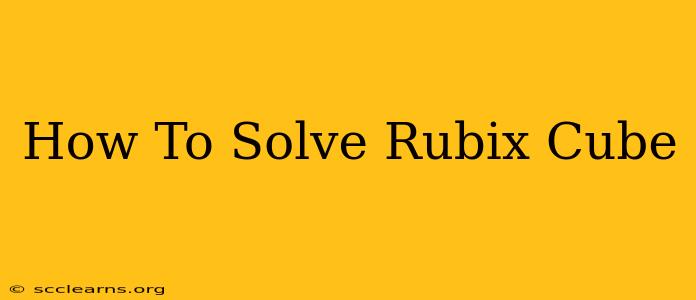So you've got a Rubik's Cube and you're staring at it, completely baffled? Don't worry, millions have been there before you! Solving a Rubik's Cube might seem impossible at first glance, but with a little patience and the right method, you can conquer this iconic puzzle. This guide will break down the process into manageable steps, turning you from a Rubik's Cube novice into a solving pro.
Understanding the Rubik's Cube
Before we dive into the solution, let's understand the basics. A standard Rubik's Cube has six faces, each with nine colored squares. The goal is to manipulate the cube so that each face shows only one color. We'll be using standard notation to describe the moves:
- F (Front): The face you're looking at.
- B (Back): The face opposite the front.
- R (Right): The face to your right.
- L (Left): The face to your left.
- U (Up): The face on top.
- D (Down): The face on the bottom.
A single quote (') after a letter indicates a counter-clockwise rotation of that face by 90 degrees. A '2' indicates a 180-degree rotation.
The Beginner's Method: Solving the Cube Step-by-Step
We'll use a layer-by-layer method, the most popular approach for beginners. This method breaks down the solution into several stages:
1. The White Cross
The first step is to create a white cross on the top face (the Up face). This involves manipulating the edge pieces (pieces with two colors) to form a plus sign (+) with the white center. There's no single algorithm for this; it requires a bit of intuition and trial and error. Focus on getting the white edges into their correct positions relative to the white center. Don't worry about the orientation of the edges at this stage.
2. Completing the White Layer
Once you have the white cross, complete the first layer by solving the four corner pieces. This involves bringing the white corner pieces to their correct positions. There are specific algorithms to help with this; you'll find many helpful tutorials online demonstrating these moves visually.
3. The Middle Layer
Now, we move to the middle layer. This step involves bringing the four edge pieces of the middle layer into their correct positions. Again, algorithms will be your friend here, helping you precisely move these pieces without disrupting the solved white layer.
4. The Yellow Cross
Next, we'll solve the yellow cross on the top layer. This is often easier than it sounds. Several algorithms can help orient the yellow edges to create a yellow cross.
5. Orienting the Yellow Corners
Now, we orient the yellow corners. This means getting all the yellow corners to their correct positions, even if they're not yet oriented correctly.
6. Permuting the Yellow Corners
The final step involves permuting (positioning) the yellow corners correctly, ensuring they are in their final places. Specific algorithms will help you perform this task.
7. Permuting the Yellow Edges
Finally, we position the yellow edges to complete the cube. This is the last step in the process.
Resources for Learning
Learning to solve a Rubik's Cube is a journey, not a sprint. Don't be discouraged if you don't get it right away. There are tons of fantastic resources available online:
- YouTube Tutorials: Search YouTube for "beginner Rubik's Cube tutorial." Many excellent visual guides break down each step clearly.
- Rubik's Cube Apps: Several mobile apps offer interactive tutorials and step-by-step guidance.
- Online Solvers: While not ideal for learning, online solvers can help you visualize the solution and understand the algorithms.
Mastering the Rubik's Cube takes time and practice, but the satisfaction of solving it is immensely rewarding. Stick with it, and you'll be amazed at what you can achieve! Remember to celebrate your progress along the way – each completed stage is a victory!

